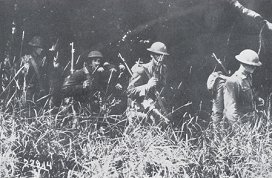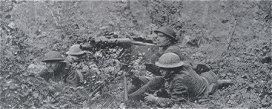
Second Tennessee Infantry
 No
Knoxville organization of men made a more commendable record or participated
more actively in the operations in Belgium and against the Hindenburg
Line in Flanders than those who went to Camp Sevier as members of the
Second Tennessee Infantry. Yet because this regiment was merged
with others in the organization of the Thirtieth Division and its officers
and men scattered through several different units of the division, it
has never received the credit and the glory it should have for its splendid
record both in training camp and on the battlefield. [Photo
at right - "In Combat Formation: Infantrymen advancing toward
the German lines in an attack upon the Huns."]
No
Knoxville organization of men made a more commendable record or participated
more actively in the operations in Belgium and against the Hindenburg
Line in Flanders than those who went to Camp Sevier as members of the
Second Tennessee Infantry. Yet because this regiment was merged
with others in the organization of the Thirtieth Division and its officers
and men scattered through several different units of the division, it
has never received the credit and the glory it should have for its splendid
record both in training camp and on the battlefield. [Photo
at right - "In Combat Formation: Infantrymen advancing toward
the German lines in an attack upon the Huns."]
The Second Tennessee was raised largely through the efforts of Colonel James A. Gleason, of Knoxville, who was commissioned lieutenant-colonel, with Charles B. Rogan, adjutant general of Tennessee, as colonel and commander of the organization. The majority of General Rogan's time was needed in the administration of his state office, and so the burden of organizing most of the companies and the task of equipping and whipping them into military units fell largely to Colonel Gleason during the summer of 1917. The state was aflame with the war spirit and so little difficulty was experienced in raising the new regiment, the companies of which were liberally distributed over the three grand divisions of the state.
The formal organization of the regiment was: Charles B. Rogan, of Nashville, colonel and commander; James A. Gleason, of Knoxville, lieutenant-colonel; Roane Waring, of Memphis, Hal Holmes, of Trenton, and James W. Birks, of Livingston, majors; Headquarters Company, of Nashville and Memphis, Captain George Hedge; Supply Company, of Nashville, Captain Harry Manners; Regimental Infirmary, of Knoxville, Major Robert H. Newman; Company A, of Dover and Cumberland City, Captain Thomas Miller; Company B, of Nashville and Fayetteville, Captain John L. Craig; Company C, of Livingston, Captain Timothy E. Stephens; Company D, of Crossville, Captain David Southard; Company E, of Newport, Captain Joseph Gaffney; Company F, of Bristol and Harriman, Captain Thomas Fauntleroy; Company G, of Knoxville, Captain William H. Beckner; Company H, of Rockwood, Captain T. Asbury Wright, Jr.; Company I, of Trenton, Captain William W. Wade; Company K, of Dyersburg, Captain William G. Green; Company L, of Memphis, Captain Frazier Hinton; Company M, of Memphis, Captain William F. Murrah, Machine Gun Company, of Murfreesboro, Captain Thomas Y. English.
In addition to Company G and the Regimental Infirmary, of Knoxville, there were scores of Knoxville men who, after their enlistment at home, were transferred to other companies of the regiment to fill them up to the necessary strength. In all, a fair estimate of the number of Knox County men who enlisted in the Second Tennessee would be between 400 and 500. They were stout, vigorous men, most of whom had never been in a military organization before, and who came straight from civil life to serve during the period of the emergency.
 [Photo
at right - "Over the Top: A machine gun crew creeping toward
the enemy lines through the woods. A realistic picture of an actual
front-line advance."] The regiment entrained and departed
with the other organizations of the state national guard to Camp Sevier
in the early days of September, 1917. A short time after its arrival,
the reorganization of the regiments of the national guard of Tennessee
and North and South Carolina took place under the direction of Major-General
John F. Morrison, commander of the Thirtieth Division.
The First Tennessee Infantry was converted into the 115th Field
Artillery; the Third Tennessee Infantry became the 117th Infantry; the
First Tennessee Field Artillery was numbered the 114th Field Artillery;
Troops A, B, and C, of Cavalry, were converted into the 114th Machine
Gun Battalion, while Troop D, of Knoxville, became the Trench Mortar Battery
of the division. The hardest luck fell to the lot of the Second
Tennessee, the last Tennessee organization, which was made a part of the
Fifty-ninth Depot Brigade, destined later to furnish many of the replacements
for the new organizations of the division, all of which were below the
new war strength. [Photo above shows troops going
over the top of a line.]
[Photo
at right - "Over the Top: A machine gun crew creeping toward
the enemy lines through the woods. A realistic picture of an actual
front-line advance."] The regiment entrained and departed
with the other organizations of the state national guard to Camp Sevier
in the early days of September, 1917. A short time after its arrival,
the reorganization of the regiments of the national guard of Tennessee
and North and South Carolina took place under the direction of Major-General
John F. Morrison, commander of the Thirtieth Division.
The First Tennessee Infantry was converted into the 115th Field
Artillery; the Third Tennessee Infantry became the 117th Infantry; the
First Tennessee Field Artillery was numbered the 114th Field Artillery;
Troops A, B, and C, of Cavalry, were converted into the 114th Machine
Gun Battalion, while Troop D, of Knoxville, became the Trench Mortar Battery
of the division. The hardest luck fell to the lot of the Second
Tennessee, the last Tennessee organization, which was made a part of the
Fifty-ninth Depot Brigade, destined later to furnish many of the replacements
for the new organizations of the division, all of which were below the
new war strength. [Photo above shows troops going
over the top of a line.]
The transfer of the men and officers of the depot brigade did not take place immediately, however. Drilling was continued daily, and the same vigorous schedule that was outlined for the rest of the division was kept by all the companies and battalions of the brigade. In spite of the certainty that the separation would come in a few days or weeks, the esprit de corps of the Second Tennessee was kept at the highest mark, and many of the men and officers refused voluntary transfers to other organizations. They held the faint hope that some change might be made by which they might be held together as a unit and go overseas together.
The order for the compulsory transfer of the officers and men of the regiment came on October 22, 1917. The large majority of the men were sent to the 119th and 120th Infantry regiments of the Sixtieth Brigade, some few to the three machine gun battalions of the division, while still others went to the artillery regiments and the other units of the division. The officers were more widely scattered than the men. Col. Rogan was placed on the unassigned list; Lieutenant-Colonel Gleason went to the 114th Field Artillery with the same rank, but later received his promotion to a full colonelcy; while the line officers mainly stayed with the infantry regiments, though some few transferred to the artillery. The majority of them went with their men into the Sixtieth Brigade, the 119th and 120th regiments.
The history of the Sixtieth Brigade is largely that of the Fifty-ninth Brigade, the story of which has been told in [a separate page]. They fought side by side in Belgium and Flanders, each relieving the other to take up the drive against the German forces. The Sixtieth, together with units of the Fifty-ninth, made the assault upon the Hindenburg Line. The Fifty-ninth had the honor of launching the attack on October 8, while the Sixtieth took up the attack two days later. The Fifty-ninth also started the drive on October 17, which was taken up a day later by the Sixtieth.
Of the honors and decorations they won, the deaths and wounds they sustained, the battles and engagements in which the individual men and officers of the Second Tennessee Infantry from Knox County took part, only their individual records, which are given elsewhere, will tell fully. They will show that these men won their share and did their part to the utmost. All commanders under whom they served paid tribute to their courage, fidelity, and soldierly qualities. Had they been allowed to remain together as the unit in which they were organized, there is no doubt they would have made the same illustrious record which other Tennessee regiments did during the great war.
[ Return to Knox County Genealogy Military Page ]
[ Return to Knox County Genealogy Main Page ]
Except as noted, all HTML code and graphics in the URL path [http://www.knoxcotn.org/military/wwi/] were created by and copyrighted 2001-2003 to Billie R. McNamara. All rights reserved. Please direct all questions and comments to Ms. McNamara.This page was last updated January 2, 2004. Visitor